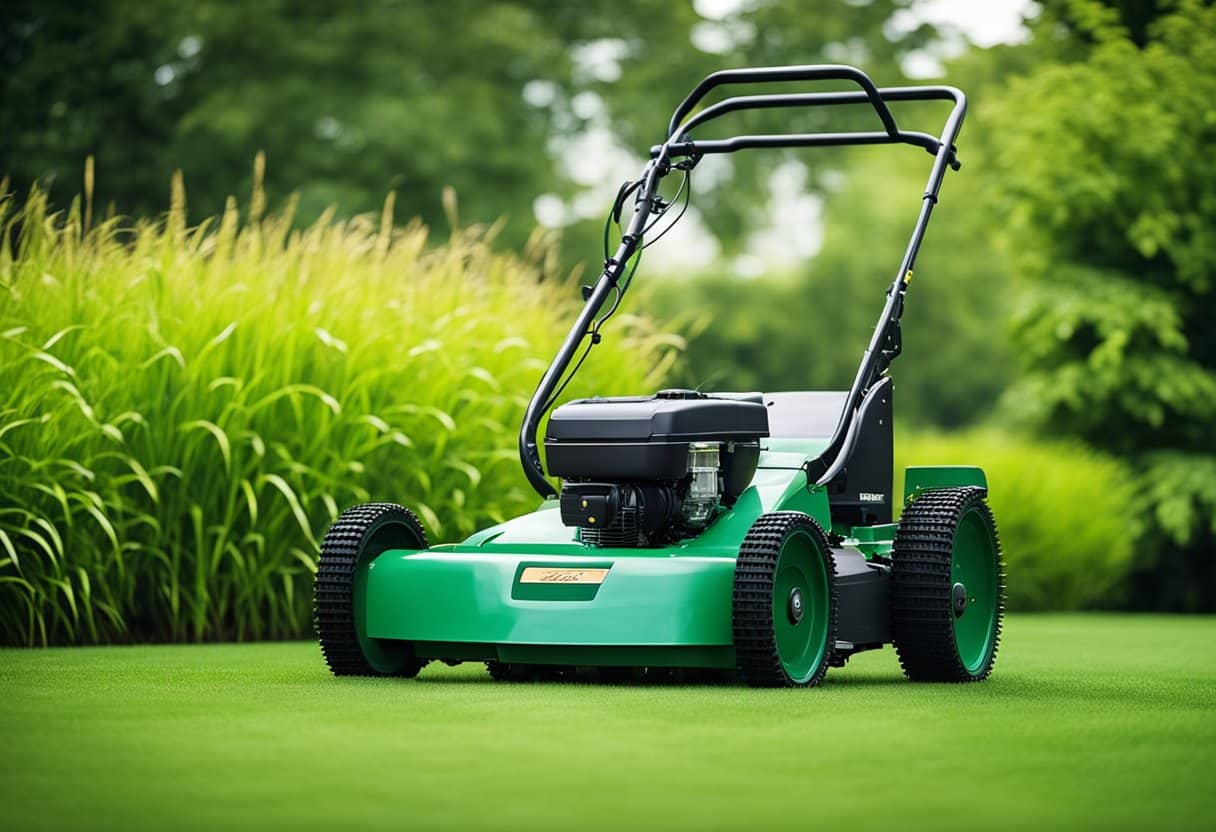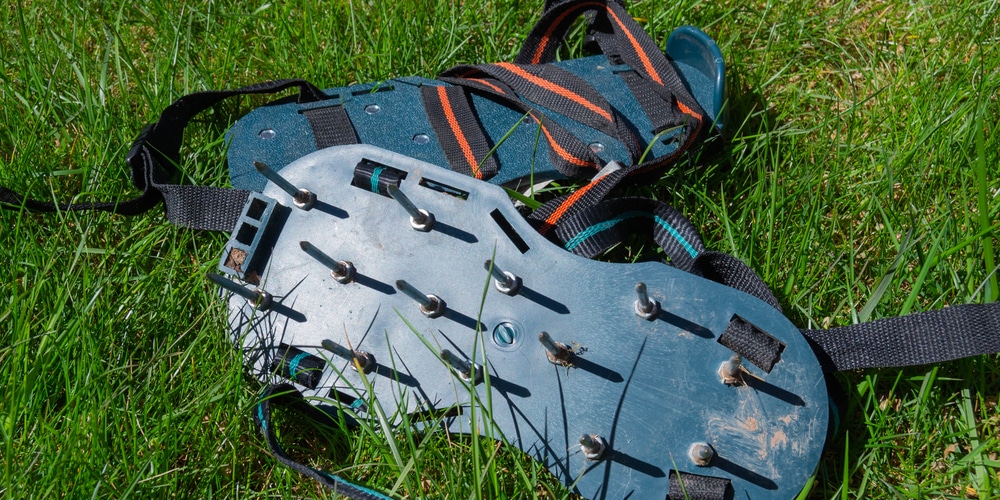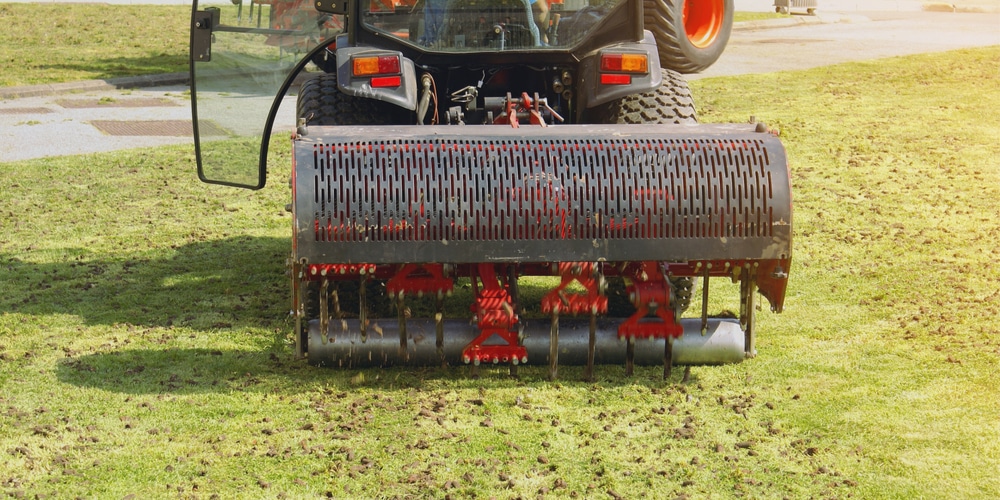Struggling with a patchy, unhealthy lawn? You might need to give your grass a bit of TLC.
Two tools that can help are scarifiers and aerators. These lawn care heroes can transform your sad, worn-out turf into a lush green paradise.

A scarifier removes dead grass and moss, while an aerator creates small holes in the soil to improve air, water, and nutrient circulation.
Both tools work wonders for your lawn’s health, but they serve different purposes.
Knowing when and how to use each can make the difference between a mediocre yard and the envy-inducing lawn of your dreams.
Ready to dive into the world of lawn care wizardry? Let’s explore the ins and outs of scarifiers and aerators to help you choose the right tool for your grass-growing goals.
You’ll be amazed at how these simple machines can breathe new life into your outdoor space.
Key Takeaways
- Scarifiers remove thatch and moss, while aerators reduce soil compaction
- Regular use of both tools can significantly improve lawn health and appearance
- Proper timing and technique are crucial for achieving the best results with scarifiers and aerators
Lawn Health and Maintenance
Keeping your lawn lush and green isn’t just about mowing and watering.
It’s like maintaining your car – sometimes you need to get under the hood to keep things running smoothly.
Let’s dive into the nitty-gritty of lawn care that’ll have your neighbors green with envy.
Understanding Soil Compaction and Thatch
Ever feel like your lawn is as hard as your driveway? That’s soil compaction, folks. It’s like your grass is trying to grow through concrete.
Compacted soil makes it tough for roots to spread and water to penetrate. Your grass ends up thirsty and weak, much like a car engine running on fumes.
Thatch is another pesky problem. It’s that layer of dead grass and roots between the soil and the green stuff.
A little thatch is fine, but too much is like a clogged air filter – it chokes your lawn.
The Essentials of Aeration
Aeration is your lawn’s equivalent of a good oil change. It punches holes in your soil, letting air, water, and nutrients reach the roots.
You’ve got two main types of aerators:
- Spike aerators: They poke holes in the ground
- Core aerators: They actually remove plugs of soil
Core aerators are generally more effective, giving your lawn’s roots more room to stretch out.
It’s like giving your grass a nice, comfy bed to grow in.
Aerate when your soil is moist but not waterlogged. Spring or fall are usually the best times, depending on your grass type.
Benefits of Regular Scarification
Scarification is like detailing your car – it gets rid of all the gunk. In this case, it’s removing that pesky thatch we talked about earlier.
A scarifier uses blades to cut through the thatch, pulling it up and out of your lawn.
It’s a bit rough on your grass, but sometimes you need to be cruel to be kind.
Regular scarification:
- Improves air and water penetration
- Encourages stronger root growth
- Helps your lawn look greener and healthier
You don’t need to scarify as often as you change your oil, but once a year can work wonders for most lawns. Just like with your car, a little preventative maintenance goes a long way in keeping your lawn running smoothly.
Tools of the Trade: Scarifiers and Aerators
You’ve got two trusty sidekicks in your quest for the perfect lawn: scarifiers and aerators. These unsung heroes of turf maintenance come in various shapes and sizes, each with their own special talents.
Manual vs. Electric Scarifiers
Manual scarifiers are like the classic muscle cars of lawn care. They’re simple, reliable, and give you a workout.
You’ll feel like a proper gardener as you push and pull those tines through your grass.
Electric scarifiers, on the other hand, are the sporty EVs of the lawn world. They’re powered by electricity and make quick work of thatch removal. No oil changes or tune-ups required!
If you’ve got a postage stamp-sized lawn, a manual scarifier might do the trick. But for larger areas, an electric model will save your back and your Saturday afternoon.
Spike, Core, and Liquid Aerators
Spike aerators are the lawn equivalent of acupuncture. They poke tiny holes in your soil, helping air and water penetrate. Great for a quick fix, but not as thorough as their cousins.
Core aerators are the heavy lifters. They remove plugs of soil, creating space for roots to breathe and grow.
Think of them as giving your lawn tiny lung transplants.
Liquid aerators are the new kids on the block. They use chemicals to break up compacted soil.
Easy to apply, but they might not be as effective as mechanical methods for severely compacted lawns.
Choosing the Right Equipment for Your Lawn
Picking the right tool is like choosing the perfect car for a road trip.
Consider your lawn’s size, soil type, and how much elbow grease you’re willing to invest.
For small lawns, manual tools might suffice. Larger areas? You’ll want powered equipment to avoid turning lawn care into an Olympic sport.
Assess your garden’s needs. If thatch is your nemesis, a scarifier’s your best bet. Dealing with compacted soil? An aerator’s got your back.
Remember, quality matters. A well-built tool will last longer than that “bargain” that falls apart after one use. Your lawn will thank you for investing in the right equipment.
The Process of Aeration and Scarification

You’re about to give your lawn some TLC. These processes help your grass breathe and grow, like giving your car a tune-up.
Let’s walk through how to aerate and scarify your lawn.
Step by Step: Aeration
First, you’ll want to water your lawn thoroughly. This softens the soil, making it easier for the aerator to do its job. It’s like prepping your car before a paint job.
Next, fire up that aerator.
You’ll be poking holes in your lawn, but don’t worry – it’s all part of the plan. Soil aeration improves water penetration and air circulation.
Run the aerator over your lawn in straight lines, just like you’re mowing.
You’ll see little soil plugs popping up – that’s a good sign! These cores will break down naturally, feeding your lawn.
Remember to overlap your passes slightly. You don’t want to miss any spots, just like when you’re waxing your car.
Step by Step: Scarification
Now, let’s move on to scarification. This process removes thatch, that pesky layer of dead grass and roots.
Think of it as scraping off old paint before applying a fresh coat.
Start by mowing your lawn short. You want to get as close to the thatch as possible. It’s like stripping your car down before customizing it.
Fire up your scarifier and run it over your lawn in straight lines.
You’ll see it pulling up thatch and moss. Don’t be alarmed if your lawn looks a bit rough afterward – it’ll bounce back stronger.
Make a second pass at right angles to the first. This ensures you’ve covered all areas, just like when you’re buffing out scratches on your car’s paintwork.
After scarifying, rake up all the debris. Your lawn might look a bit bare, but don’t worry.
It’s now primed for nutrient absorption and ready to grow lush and green.
Enhancing Growth: Overseeding and Lawn Care
Ready to rev up your lawn’s growth? Let’s dive into the nitty-gritty of overseeding and lawn care.
These techniques will have your grass purring like a finely-tuned engine in no time.
The Benefits of Overseeding Post-Aeration
You know how a car needs regular oil changes? Well, your lawn needs overseeding after aeration. It’s like giving your grass a turbo boost.
Overseeding after aeration helps seeds make direct contact with the soil.
This increases their chances of germination, much like how premium fuel improves your car’s performance.
Think of those aeration holes as tiny garages for your grass seeds. They provide the perfect environment for growth, protected from birds and wind.
Plus, these holes retain moisture, giving your seeds the hydration they need to sprout.
Maintaining a Healthy Grass Growth
Once your grass is growing, you’ll want to keep it in top shape.
It’s like maintaining a classic car – it takes work, but the results are worth it.
Regular mowing is crucial. Keep your grass at the right height, just like you’d keep your tires properly inflated.
Don’t cut more than one-third of the blade length at a time.
Water deeply but infrequently. It’s like giving your lawn a good wash, not just a quick rinse.
This encourages deep root growth, making your grass more resilient.
Fertilize smartly. Like using the right grade of oil, choose a fertilizer that suits your grass type and season.
And remember, more isn’t always better – over-fertilizing can harm your lawn.
Special Considerations for Lawn Care
When it comes to keeping your grass lush and healthy, size matters – and so does timing.
Let’s rev up our lawn care engines and explore some key factors that’ll have your turf purring like a well-oiled machine.
Treating Large Lawns vs. Small Patches
Got a lawn the size of a football field? You might want to consider investing in a ride-on lawn aerator or scarifier.
These bad boys can cover ground faster than you can say “grass clippings.”
For smaller patches, a manual garden fork might do the trick. It’s like the trusty old screwdriver in your toolbox – simple but effective.
Remember, compacted soils are the sworn enemy of a healthy lawn. If your grass feels like concrete underfoot, it’s time to break out the big guns.
Best Practices for Year-Round Lawn Vigor
Your lawn, like your car, needs regular maintenance to stay in top shape.
In spring, give it a good once-over with a scarifier to remove thatch. It’s like clearing out the air filter – lets your grass breathe easier.
Come summer, keep your mower blades high. Short grass is like an overheated engine – it’ll burn out fast.
In fall, aerate those compacted soils. It’s like changing the oil – keeps everything running smoothly.
Winter? Let your lawn hibernate. No need to rev the engine when it’s freezing outside.
Frequently Asked Questions
Lawn care can be confusing, especially when it comes to specialized tools.
What’s the real difference between a lawn scarifier and a lawn aerator?
A scarifier and an aerator are like the dynamic duo of lawn care, each with their own superpowers.
Scarifiers remove thatch from your lawn, that pesky layer of dead grass and debris. Aerators, on the other hand, are the soil’s best friend, poking holes to improve air and water circulation.
Think of a scarifier as your lawn’s exfoliator, while an aerator is more like giving your soil a deep tissue massage. Both tools aim to make your grass happier and healthier, just in different ways.
When should I opt for scarifying over aerating my lawn?
You might want to reach for the scarifier when your lawn feels a bit spongy underfoot. This usually means you’ve got a thatch problem.
If your grass looks a bit lackluster despite your best efforts, it’s probably crying out for a good scarifying session.
Aerating, however, is your go-to when the soil feels compacted. If water pools on your lawn after rain or your grass struggles to grow, it’s time to aerate.
Remember, scarifying is more intense and shouldn’t be done as frequently as aerating.
Can a scarifier effectively aerate the soil, or should I invest in a separate tool?
While a scarifier might give your soil a bit of a tickle, it’s not really designed for aeration. Scarifiers work on the surface, removing thatch, while aerators go deeper, creating those all-important air pockets in the soil.
If you’re serious about lawn care, you might want to invest in both tools.
Think of it like having both a spatula and a whisk in your kitchen – they each have their specific jobs, and you’ll get the best results using the right tool for the task.
What’s the order of operation for lawn care: Do I scarify or aerate first?
Good question! The order can make a difference.
Generally, you’ll want to scarify first, then aerate. This way, you’re clearing out the dead stuff before you start working on the soil underneath.
Think of it like cleaning your house. You’d vacuum before mopping, right? Same principle applies here. Get rid of the thatch with your scarifier, then let your aerator do its thing.
Are there distinct benefits of scarifying compared to aerating?
Absolutely! Scarifying is like giving your lawn a fresh start. It clears out all that dead grass and moss, letting your healthy grass breathe and grow.
Aerating, meanwhile, is more about what’s going on beneath the surface. It helps water and nutrients penetrate deeper into the soil, promoting stronger root growth. Both have their place in a healthy lawn care routine.
Could I use a dethatcher instead of a scarifier, or are they the same thing?
Ah, the old dethatcher vs scarifier debate! These two are like cousins – related, but not quite the same.
A dethatcher is generally gentler, using tines to pull out dead grass and debris. Meanwhile, a scarifier is more aggressive, using blades to cut into the thatch layer.
If you’ve got a mild thatch problem, a dethatcher might do the trick. But for tougher jobs, you’ll want the extra oomph of a scarifier.
It’s like choosing between a butter knife and a steak knife – sometimes you need that extra cutting power!
